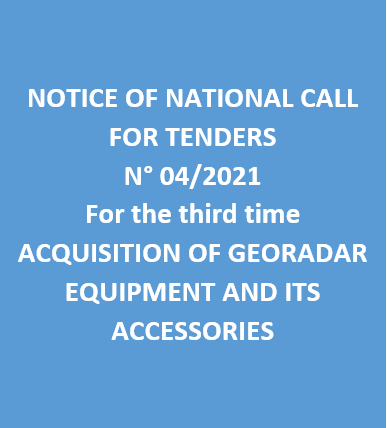| Annual program and technical progress report |
-

Activity Report 2023
-

Technical Program 2024
|
| Geocatalogue |

|
| Invitation to
tender |
-

REALIZATION OF THE TRAINING PLAN FOR THE YEAR 2022
-

ACQUISITION OF TWO SERVICE CARS
-

ACQUISITION OF GEORADAR EQUIPMENT AND ITS ACCESSORIES
|
|
Invest in Tunisia |

|
|
|
|
|
::
Documentation and Editions
>>
Research library
|
| |
|
[
Search by author
]
[
Search keyword
]
[
Search by index
]
[
Search by category
]
|
title of the reference :
|
The early Toarcian (Jurassic) anoxic event
|
|
Publication Date:
|
1988
|
|
Author :
|
Jenkyns H.C.
|
|
Catalogue type :
|
Livre
|
|
Catalogue reference :
|
Vol. 288 (USA) Am. J. Sci. Vol. 288 The early Toarcian (Jurassic) anoxic event Les manifestations anaérobies au Toarcien inférieur (Jurassique) : preuves stratigraphiques, sédimentologiques et géochimiques. stratigraphic, sedimentary and geochemical evidence. Detailed stratigraphic studies of jurassic deep-marine tethyan organic-rich shales and manganoan carbonates from Austria,Germany,Italy,Greece,Hungary and Tunisia suggests that they are principally of early Toarcian,falciferum-zone age.Carbon-isotope stratigraphy from non-carbonaceous tethyan sections indicates a positive ?13C excursion in the early part of the falciferum-zone (exaratum subzone)suggesting accelerated extraction of organic carbon from the ocean reservoir at this time,and it is likely that most,if not all,thethyan Jurassic black shales are confined to this interval:they can thus be used as a stratigraphic index.These facies are of exactly equivalent age to the more renowned equivalents in epicontinental northern Europe .It is thus clear that synchronous deposition of these facies occured in diverse parts of the globe which allowed interpretation of the phenomenon as an oceanic anoxic event,whose duration is estimated as approximately half-a-million years.Detailed paleogeographic studies in the southern alps suggest that oxygen-minimum model is appropriate for interpreting conditions on the tethyan continental margins.Advection of manganese in this low-oxygen layer may explain the local occurence of carbonate ores of this element.Carbon-sulfur and iron sulfure ratios,although showing considerable scatter,suggest that bottom waters at this time were locally euxinic,containing free hydrogen sulfide.This oceanic anoxic event was preceded by significant faunal turnover of ammonites in the Tethys and accompanied by widespread extinction of benthos in northern Europe in response to the lateral spread of anoxic bottom waters during transgression.Similar changes may be recognized in other parts of the world.Other anoxic events may have taken place during the Jurassic,but documentation is as yet meager.Furthermore,models for such phenomena remain largely speculative,although upwelling and increased planktonic productivity,commencing in pre-toarcian time,are favored for the falciferum-zone event documented here.
bibliogr. Tethys ; milieu anaérobie ; C13 C12 ; shale ; roche carbonatée ; milieu marin ; isotope ; synthèse bibliographique ; bibliographie ; fer ; soufre ; paléogéographie ; paléoocéanographie ; corrélation ; biostratigraphie ; sédimentation ; Jurassique inférieur ; Toarcien ; Tunisie ; Tunisie Orientale Sahel ; Europe ; Région Méditerranéenne ; El Fahs Jenkyns H.C. Stratigraphie
|
|
Indexation decimale :
|
Stratigraphie
|
|
Keywords :
|
Tethys ; milieu anaérobie ; C13 C12 ; shale ; roche carbonatée ; milieu marin ; isotope ; synthèse bibliographique ; bibliographie ; fer ; soufre ; paléogéographie ; paléoocéanographie ; corrélation ; biostratigraphie ; sédimentation ; Jurassique inférieur ; Toarcien ; Tunisie ; Tunisie Orientale Sahel ; Europe ; Région Méditerranéenne ; El Fahs
|
|
Summary :
|
Detailed stratigraphic studies of jurassic deep-marine tethyan organic-rich shales and manganoan carbonates from Austria,Germany,Italy,Greece,Hungary and Tunisia suggests that they are principally of early Toarcian,falciferum-zone age.Carbon-isotope stratigraphy from non-carbonaceous tethyan sections indicates a positive ?13C excursion in the early part of the falciferum-zone (exaratum subzone)suggesting accelerated extraction of organic carbon from the ocean reservoir at this time,and it is likely that most,if not all,thethyan Jurassic black shales are confined to this interval:they can thus be used as a stratigraphic index.These facies are of exactly equivalent age to the more renowned equivalents in epicontinental northern Europe .It is thus clear that synchronous deposition of these facies occured in diverse parts of the globe which allowed interpretation of the phenomenon as an oceanic anoxic event,whose duration is estimated as approximately half-a-million years.Detailed paleogeographic studies in the southern alps suggest that oxygen-minimum model is appropriate for interpreting conditions on the tethyan continental margins.Advection of manganese in this low-oxygen layer may explain the local occurence of carbonate ores of this element.Carbon-sulfur and iron sulfure ratios,although showing considerable scatter,suggest that bottom waters at this time were locally euxinic,containing free hydrogen sulfide.This oceanic anoxic event was preceded by significant faunal turnover of ammonites in the Tethys and accompanied by widespread extinction of benthos in northern Europe in response to the lateral spread of anoxic bottom waters during transgression.Similar changes may be recognized in other parts of the world.Other anoxic events may have taken place during the Jurassic,but documentation is as yet meager.Furthermore,models for such phenomena remain largely speculative,although upwelling and increased planktonic productivity,commencing in pre-toarcian time,are favored for the falciferum-zone event documented here.
|
|
Exemplaries :
|
TU661
|
|
|
|
|
|
|
|



